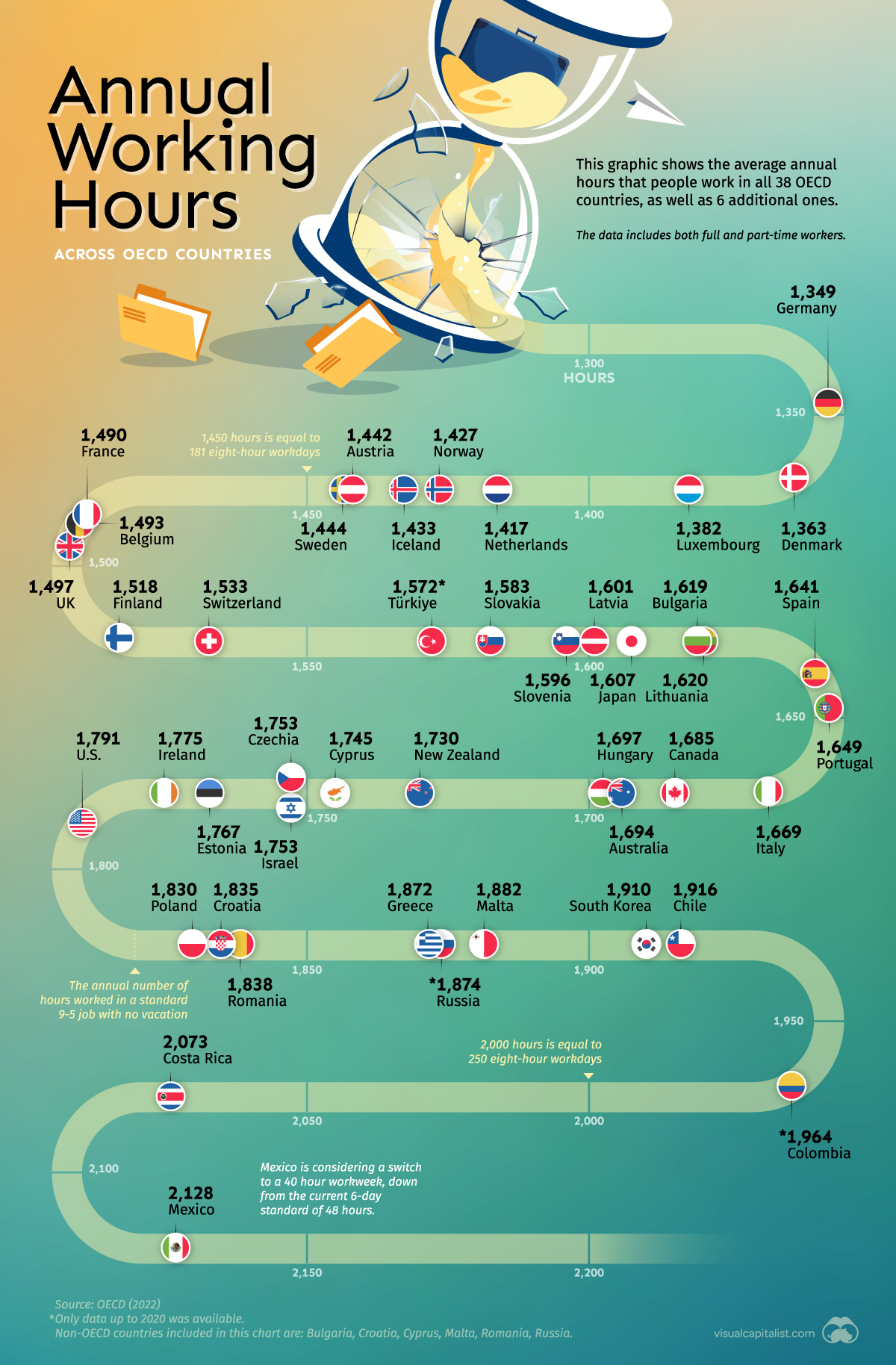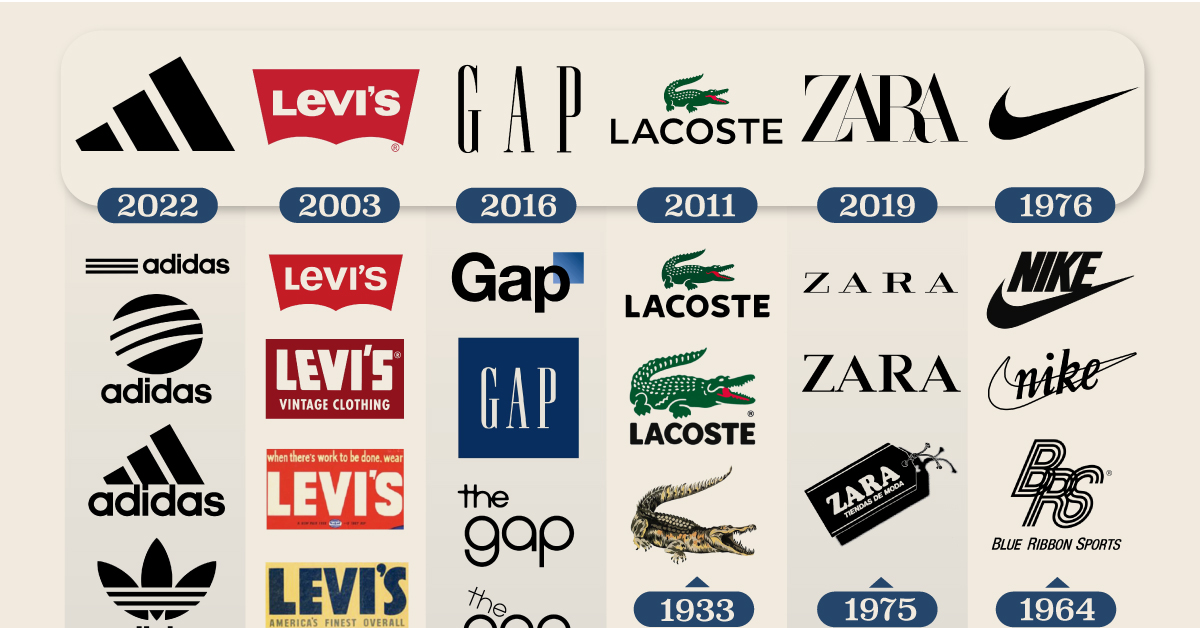Business
Visualizing Annual Working Hours in OECD Countries

Visualizing Annual Working Hours in OECD Countries
Comparing the number of hours people work in different countries can provide insight into cultural work norms, economic productivity, and even labor laws.
With this in mind, we’ve ranked OECD countries (plus a few others) based on their average annual hours worked. Note that this data includes both full-time and part-time workers.
Data and Highlights
The data we sourced from OECD is listed in the table below. All figures are as of 2021 (latest available), with the exception of Colombia, Russia, and Türkiye which are as of 2020.
| Country | Average annual hours worked |
|---|---|
| 🇲🇽 Mexico | 2,128 |
| 🇨🇷 Costa Rica | 2,073 |
| 🇨🇴 Colombia | 1,964 |
| 🇨🇱 Chile | 1,916 |
| 🇰🇷 South Korea | 1,910 |
| 🇲🇹 Malta* | 1,882 |
| 🇷🇺 Russia* | 1,874 |
| 🇬🇷 Greece | 1,872 |
| 🇷🇴 Romania* | 1,838 |
| 🇭🇷 Croatia* | 1,835 |
| 🇵🇱 Poland | 1,830 |
| 🇺🇸 United States | 1,791 |
| 🇮🇪 Ireland | 1,775 |
| 🇪🇪 Estonia | 1,767 |
| 🇨🇿 Czech Republic | 1,753 |
| 🇮🇱 Israel | 1,753 |
| 🇨🇾 Cyprus* | 1,745 |
| 🇳🇿 New Zealand | 1,730 |
| 🌐 OECD average | 1,716 |
| 🇭🇺 Hungary | 1,697 |
| 🇦🇺 Australia | 1,694 |
| 🇨🇦 Canada | 1,685 |
| 🇮🇹 Italy | 1,669 |
| 🇵🇹 Portugal | 1,649 |
| 🇪🇸 Spain | 1,641 |
| 🇱🇹 Lithuania | 1,620 |
| 🇧🇬 Bulgaria* | 1,619 |
| 🇯🇵 Japan | 1,607 |
| 🇱🇻 Latvia | 1,601 |
| 🇸🇮 Slovenia | 1,596 |
| 🇸🇰 Slovakia | 1,583 |
| 🇹🇷 Türkiye | 1,572 |
| 🇨🇭 Switzerland | 1,533 |
| 🇫🇮 Finland | 1,518 |
| 🇬🇧 United Kingdom | 1,497 |
| 🇧🇪 Belgium | 1,493 |
| 🇫🇷 France | 1,490 |
| 🇸🇪 Sweden | 1,444 |
| 🇦🇹 Austria | 1,442 |
| 🇮🇸 Iceland | 1,433 |
| 🇳🇴 Norway | 1,427 |
| 🇳🇱 Netherlands | 1,417 |
| 🇱🇺 Luxembourg | 1,382 |
| 🇩🇰 Denmark | 1,363 |
| 🇩🇪 Germany | 1,349 |
*Non-OECD country
At the top is Mexico, where the average worker clocks over 2,000 hours per year. This reflects the country’s labor dynamics, which typically involves a six-day workweek. For context, 2,128 hours is equal to 266 eight-hour workdays.
The only other country to surpass 2,000 annual hours worked per worker is Costa Rica, which frequently tops the World Economic Forum’s Happy Planet Index (HPI). The HPI is a measure of wellbeing, life expectancy, and ecological footprint.
Looking at the other end of the list, the two countries that work the fewest hours are Germany and Denmark. This is reflective of the strong labor laws in these countries as well as their emphasis on work-life balance.
For example, the German Working Hours Act (Arbeitszeitgesetz) states that daily hours of work may not exceed eight hours. Days can be extended to 10 hours, but only if it averages out to eight hours per working day over a six-month period.
Working fewer hours doesn’t mean that a country is becoming less productive, though. Germany is known for its high value industries like automotive and pharmaceuticals, where robotics and other technologies can greatly enhance productivity.
This is supported by GDP per capita, in which Germany has grown substantially since 2000.
Limitations of this Data
A limitation of this dataset is that it aggregates both full-time and part-time workers. This means that in a country like Japan, where almost 40% of the workforce is non-regular (part-time, contract, etc.), the average figure could be skewed downwards.
Japan is known for its grueling office culture, and it’s likely that many workers are logging significantly more hours than the 1,607 figure reported.
If you enjoy comparisons like these, consider taking a look at our ranking of cities with the best work-life balance.
Business
Charted: How the Logos of Select Fashion Brands Have Evolved
For some fashion brands, changing logos mirror the constant loop of reinvention, over decades of building products, markets, and consumer bases.

Charted: How the Logos of Select Fashion Brands Have Evolved
This was originally posted on our Voronoi app. Download the app for free on iOS or Android and discover incredible data-driven charts from a variety of trusted sources.
A global fashion brand needs to balance maintaining a consistent style built painstakingly over the years while adapting to current trends. And for some of them, their changing logos reflect the loop of reinvention, over decades of building products, markets, and consumer bases.
We illustrate the evolution of six fashion companies’ logos over time. Data for the visualization and article is sourced from 1000logos.net.
Nike & Adidas: A Tale of Two Shoe Companies
The world’s largest footwear company, Nike began its journey as Blue Ribbon Sports in 1964. In 1971, they rebranded as Nike, inspired by the Greek goddess of victory.
The famous swoosh logo was designed in 1971 by Carolyn Davidson, at the time a Portland State University graphic design student. She was paid $35 dollars for her work (about $270 today). Twelve years later, Nike co-founder Phil Knight have her 500 Nike shares that have remained unsold.
Here’s how often some of the world’s biggest fashion brands have changed their logos since founding.
| Brand | Logo Changes |
|---|---|
| 👟 Adidas | 10 |
| 👖 Levi's | 8 |
| ✔️ Nike | 4 |
| 👕 Gap | 4 |
| 🐊 Lacoste | 3 |
| 👗 Zara | 3 |
Meanwhile, Adidas has far older origins: all the way back to 1920 Germany. Founded by Adolf Dassler, the company split into Adidas and Puma in 1947.
Dassler bought the iconic three stripes from another German sports company in 1947. In 1952, the stripes debuted on Adidas footwear at the Summer Olympics.
Currently, Adidas has several concurrent logos depending on the product line. This includes: the horizontal across a trefoil (Adidas Originals), curved across a circle (Adidas Style) or the diagonal mountain above the brand name (Adidas Performance).
-

 Maps7 days ago
Maps7 days agoMapped: Southeast Asia’s GDP Per Capita, by Country
-

 Markets2 weeks ago
Markets2 weeks agoVisualizing Global Inflation Forecasts (2024-2026)
-

 United States2 weeks ago
United States2 weeks agoCharted: What Southeast Asia Thinks About China & the U.S.
-

 United States2 weeks ago
United States2 weeks agoThe Evolution of U.S. Beer Logos
-

 Healthcare1 week ago
Healthcare1 week agoWhat Causes Preventable Child Deaths?
-

 Energy1 week ago
Energy1 week agoWho’s Building the Most Solar Energy?
-

 Markets1 week ago
Markets1 week agoMapped: The Most Valuable Company in Each Southeast Asian Country
-

 Technology1 week ago
Technology1 week agoMapped: The Number of AI Startups By Country

















